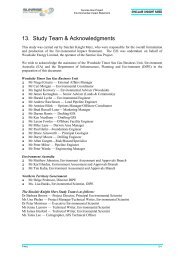Appendix D Terrestrial and Aquatic Biodiversity - Environment ...
Appendix D Terrestrial and Aquatic Biodiversity - Environment ...
Appendix D Terrestrial and Aquatic Biodiversity - Environment ...
Create successful ePaper yourself
Turn your PDF publications into a flip-book with our unique Google optimized e-Paper software.
7.3 Sensitive Habitat<br />
7.3.1 MLA Areas<br />
None of the vegetation communities are listed under any legislation (TPWC or EPBC Acts) but some types<br />
are locally noteworthy from the perspective of conserving habitat which is in good condition, features more of<br />
the atypical species, or contributes to the hydrology <strong>and</strong> connectivity within this mid part of the Towns<br />
catchment. The communities considered locally notable are listed below <strong>and</strong> described in Section 4.8.<br />
• Melaleuca Woodl<strong>and</strong>s (seasonally inundated areas);<br />
• Eucalyptus camaldulensis Woodl<strong>and</strong>s (riparian);<br />
• Tall Eucalyptus tetrodonta <strong>and</strong> Erythrophleum chlorostachys Woodl<strong>and</strong> <strong>and</strong> Callitris Woodl<strong>and</strong>; <strong>and</strong><br />
• Corymbia polycarpa Mid Woodl<strong>and</strong> (associated with a localised seepage zone or ephemeral spring)<br />
These vegetation communities are widespread in the region, but retain important biodiversity values (i.e.<br />
shelter for fauna, refuge, hollows, permanent water, food resource etc.) that are worthy of management<br />
consideration during the development of the mine plan. WDRL have aimed to reduce impact on these<br />
communities where possible during the construction of the mine <strong>and</strong> associated infrastructure.<br />
7.3.2 Haul Road<br />
There are no listed or formally recognised areas of conservation significance along the proposed haul road<br />
route. Aside from a number of localities featuring low s<strong>and</strong>stone ridges, riparian vegetation <strong>and</strong> wetl<strong>and</strong>s,<br />
none of other higher priority vegetation types such as rainforest, monsoon vine thicket <strong>and</strong> monsoon forest<br />
were found within the haul road survey area (which included a 6 km corridor).<br />
However, a number of localities do present particular value for biodiversity on a regional scale. Surveys<br />
along the haul road corridor focused on identifying <strong>and</strong> assessing the value of sensitive habitat or habitat of<br />
higher conservation value that should be avoided, <strong>and</strong> potentially buffered from the development. These<br />
sensitive habitats are listed below <strong>and</strong> described in full in Section 5.6.<br />
• Rocky S<strong>and</strong>stone Ridges (includes scattered occurrences of low rocky hills, <strong>and</strong> also the southern<br />
reaches of the Yiyintyi Ranges);<br />
• Waterbodies (includes Melaleuca swamps <strong>and</strong> seasonally inundated lowl<strong>and</strong>s); <strong>and</strong><br />
• Watercourses (includes major rivers, <strong>and</strong> smaller creek <strong>and</strong> tributary crossings).<br />
Coordinates for all surveyed locations of sensitive habitat has been provided to WDRL for use in determining<br />
the route of lowest environmental impact between the MLA areas <strong>and</strong> Bing Bong Port. The main areas that<br />
were prioritised for environmental consideration for the design <strong>and</strong> alignment of the haul road alignment are<br />
Limmen River crossing, <strong>and</strong> ridges <strong>and</strong> rocky hills to the east of Limmen River <strong>and</strong> west of Rosie Creek<br />
crossing.<br />
7.3.3 Port Facility<br />
None of the vegetation communities associated with the Bing Bong Port facility are listed under any<br />
legislation (TPWC or EPBC Acts). However, some vegetation types are locally noteworthy from the<br />
perspective of conserving habitat which is in good condition, features more of the atypical species, maintains<br />
l<strong>and</strong>form stability, or contributes to the hydrology <strong>and</strong> connectivity of this coastal community. The vegetation<br />
communities considered locally sensitive are listed below <strong>and</strong> are outline in Section 6.5.<br />
• Mangroves<br />
• Monsoon Vine Thicket Community<br />
• Cypress Pine Woodl<strong>and</strong><br />
• Melaleuca Swamp<br />
Client: Western Desert Resources Ltd Page 146 of 150<br />
Doc No. DW120004-C0302-EIA-R-0036<br />
Doc Title: <strong>Appendix</strong> D – <strong>Terrestrial</strong> <strong>Biodiversity</strong> Technical Report



